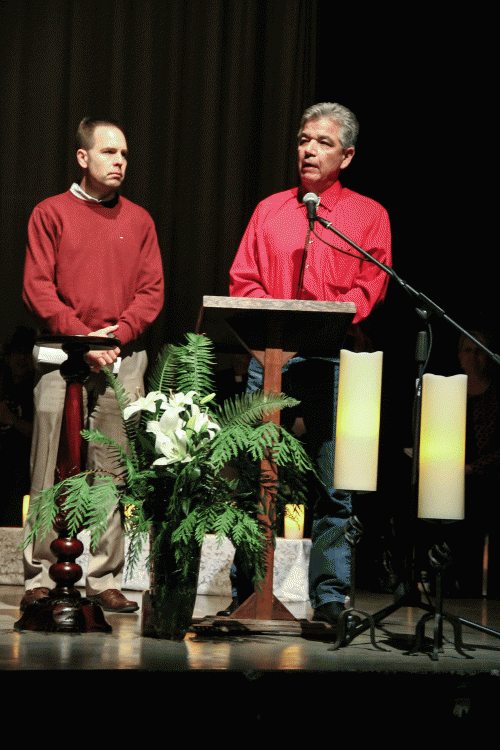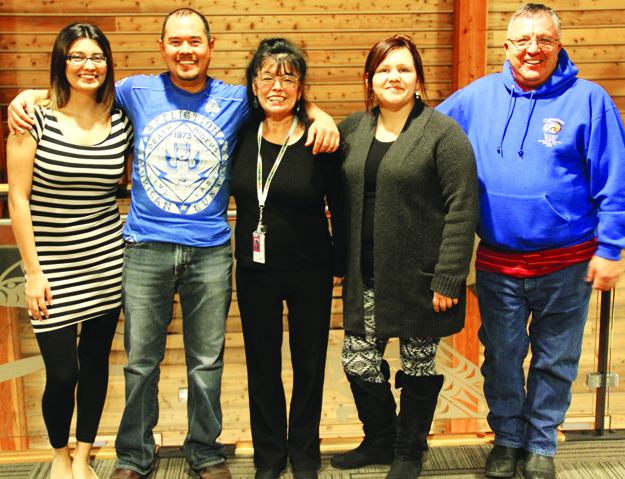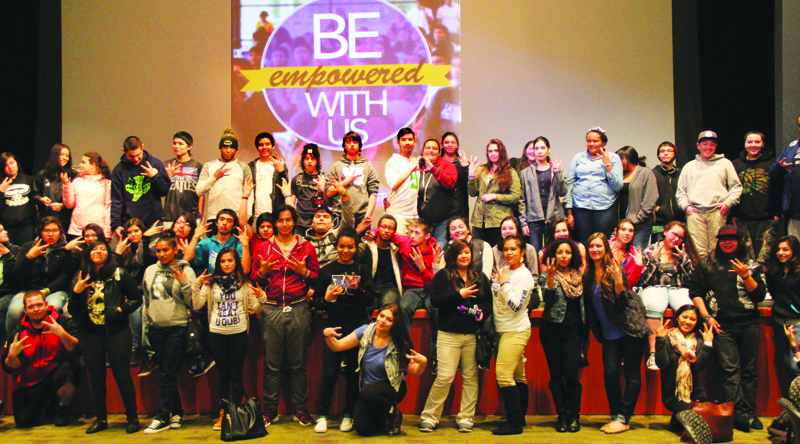Category: Tulalip News
March 4, 2015 Tulalip See-Yaht-Sub
Click the highlighted link below to download the March 4, 2015 Tulalip See-Yaht-Sub
Tribal artists collaborate to aid healing in community

By Brandi N. Montreuil, Tulalip News
TULALIP – Tulalip tribal artists, Richard “2 Doggs” Muir and David Fryberg, have begun work on a healing project for the families and students affected by the October 24 shooting at Marysville-Pilchuck High School. The healing project will consist of a large beaded staff and a brass plaque that will serve as a memorial to the only survivor and four students who were shot and killed.
“The purpose of this is for family, friends, staff and teachers to come by and remember these kids in a good way. The families can bring something and hang it off the staff if they want to. The school can make something to hang off the staff. It just symbolizes that these kids’ innocence was taken,” said Muir.

Muir, who is known for his bead work with the Native American peyote stitch, and Fryberg, who is known for his work in cedar weaving and hand drums, are reaching out to the victims’ families for input on the project’s design. Muir will be donating the beadwork that will feature a simple peyote stitch using beads to wrap around a large staff that will also feature an eagle claw atop the staff. Fryberg will be crafting the bronze plaque that will have a short healing message engraved on it.
“I want to talk to the families to ask them how do they want their kids represented in this. What would they want to see on this staff to represent their child. I would like to feature the kids’ names, either their first names or their full names, because this project is for them. It is a
symbolization of these kids, it is more than just their initials or full names, it is a symbolization of who these kids were as people, and what they brought to this world,” said Muir.
The idea for the project is loosely taken from the tradition of a journey stick or memory stick. Many Native

American tribes used staffs or large sticks as a way to memorialize a person or place. The staff is left in place and travelers are encouraged to leave a memento of personal value or representation as a memorial. The staff is from a pine tree, which symbolizes peace to many Native American tribes. The beadwork, which will feature over a 1,000 beads, will take nearly seven months to complete. Muir states the staff will be completed near the one-year anniversary date of the shooting.
“It is going to take me awhile to complete. I am going to have to set it down and set it aside because of the emotional transfer that comes with this type of work,” explains Muir about the traditional cultural practice in not crafting or completing tasks with negative thoughts. “My mind has to be in the right spot and clear of negative thoughts.”

“I want this to be for anybody who wants to take a moment to remember these kids, because who knows what these kids would have accomplished if they hadn’t been tragically murdered. They could have been the ones who invented renewable energy or saved our natural resources. We will never know now,” said Muir.
The beaded staff and bronze plaque, once complete, will be gifted to the Marysville-Pilchuck High School. Staff will then decide where the items will be placed for students and visitors to access.
Brandi N. Montreuil: 360-913-5402; bmontreuil@tulalipnews.com
Interfaith vigil brings diverse community together

By Brandi N. Montreuil, Tulalip News
MARYSVILLE – More than a hundred people attended an interfaith prayer service held in the Marysville-Pilchuck High School auditorium on Tuesday, February 24. The event, organized by Reverend Terry Kyllo with the St. Philip’s Episcopal Church in Marysville, and Father Pat Twohy, director of the Rocky Mountain Mission for the Northwest Jesuits and who has a lengthy history of chaplain services in the Tulalip community, was designed to bring together the diverse cultures represented in the Tulalip/ Marysville communities during this time of healing.
The event was held on the four-month anniversary of the October 24 shooting at the high school where Tulalip tribal member Jaylen Fryberg killed four of his classmates leaving behind one survivor, 14-year-old Nate Hatch, also his relative. Killed were 15-year-old Andrew Fryberg, also related to the shooter, Zoe Galasso, Gia Soriano and Shaylee Chuckulnaskit, all 14.
Faith leaders representing many traditions in and around Tulalip and Marysville including Christian, Buddhist, Muslim, Jewish, Sikh, Baha’i and Unitarian welcomed Tulalip/ Marysville residents to a time of silence, prayer, encouraging words, and fellowship. Also in attendance were leaders from Tulalip Tribes, who offered a prayer of healing.

(Tulalip News/ Brandi N. Montreuil)
“I know when tensions arise in the community and when there is fear that grabs hold, and there is some violence of some kind, that people have a really strong tendency to scapegoat people that they think are different than them,” said Rev. Kyllo about the idea around the interfaith service. “I started work with the recovery team and proposed in December that we might put on an interfaith service as a way to honor and celebrate the diversity of the community.”
Kyllo reached out to Father Twohy, whom he had never met, about hosting an interfaith service. “I walked up to him and I said, ‘Father Twohy, I want to do an interfaith service because we are all human and some of us don’t know that.’ He immediately said, ‘Amen brother. I am with you, give me a call.’ So we began working on the service.”
Throughout the service faith leaders shared words of encouragement before offering a prayer. Afterwards each faith leader would place a candle on table creating a circle of light meant to represent the community.
“It has been a real testing time for our community and you have all been a part of that,” Marysville Mayor Jon Nehring said to attendees. “I can tell you that I am so proud to live in a community like Tulalip/ Marysville. We really take care of one another.”

Echoing his sentiments Tulalip Tribes vice-chairman Les Parks spoke about Tulalip and Marysville’s continual support of one another. “When the mayor stands at my side here, to me it is a symbol of Marysville and the Tulalip people coming together as one community, and Dr. Berg represents all the students in the Marysville School District. To me it is important to remember why we are here. Four months ago this tragedy hit us and we lost four lives to a heinous crime, and we lost the shooter as well. We haven’t come to ask why this happened, because we will never understand why or what caused this to transpire. What we are going to do is share. We are going to cry together, grieve, heal and pray together. We are all in this together.”
Before the service concluded, a moment of silence was held for schools and communities around the world who have experienced the same type of tragedy.
Brandi N. Montreuil: 360-913-5402; bmontreuil@tulalipnews.com





February 25, 2015 Tulalip See-Yaht-Sub
Click the highlighted link below to download the February 25, 2015 Tulalip See-Yaht-Sub
February 18, 2015 Tulalip See-Yaht-Sub
Click the highlighted link below to download the February 18, 2015 Tulalip See-Yaht-Sub
Protecting unique and special employment rights of Native Americans

Photo/Micheal Rios
by Micheal Rios, Tulalip News
Within the past four decades, Tribal governments have made tremendous strides in identifying and protecting the rights, resources and opportunities of their people. Tribes are effectively exercising self-governance to protect their water, timber, hunting, fishing and gaming rights in order to garner maximum economic returns and opportunities from the use of their resources. This type of effective advocacy is being brought to the protection and assertion of Indian and Native Employment and contracting rights by approximately 300 Tribal and Alaska Native village governments that have established Tribal Employment Rights Ordinances and TERO enforcement programs (source: Pacific Northwest TERO).
Here at the Tulalip Tribes we are fortunate enough to have a fully staffed TERO department that is knowledgeable and well-equipped to protect the unique and special employment rights of Native Americans. Tulalip TERO is a member of the Pacific Northwest TERO region, which covers Washington, Oregon, Idaho, Northern California, and portions of Nevada and Alaska. Our national organization is the Council for Tribal Employment Rights. We are also fortunate to have the Tulalip TERO Commission comprised of Chairman Dale Jones, Vice-Chairperson Helen Gobin-Henson, Secretary Tisha McLean and Commission members Eliza Davis and Ryan Gobin.
Together, the TERO department and TERO Commission serve to access more employment and training opportunities for Native Americans and their families, and to provide more business and economic opportunities for businesses owned by Native Americans. Since the unemployment rate in Native communities remains high, Tribes must take strong actions to protect the employment rights of Native American people.
In protecting the employment rights of Tulalip citizens, the Tulalip TERO department and Commission administrate the TERO Program to enforce and ensure workforce protections, preferential employment and contracting rights. They assist and refer clients for education, training and services to succeed and enhance their career and economic opportunities. Their mission is to ensure preference in employment, contracting and economic opportunities, while providing vocational training opportunities with the outcome of employment.
The current TERO structure in place has been widely successful, evident in the current Tulalip preference scale found in the Central Employment hiring guidelines and the ever expanding vocational training center that has made employment dreams a reality for so many tribal members.
As the Tulalip Tribes, tribal membership, and policies continue to evolve, so does the social and political climate for Tulalip TERO. Each member of the TERO Commission, each a Tulalip tribal member, has a different set of objectives they would like to see achieved in 2015.
TERO Commission objectives to accomplish in 2015:
Dale Jones works for Tulalip’s Elders Program and is Chairman of the TERO Commission: “Equal employment and an equal wage for all of our tribal members. That’s the reason I’m here. I hear of a lot of discrepancies in hiring, people getting promoted in our tribe without advertisement. I want to put a stop to that. Can’t keep putting our head under the table and say everything is going to be okay.”
Helen Gobin-Henson works as the program manager of the Care Giver and CHR program and is Vice-Chairperson of the TERO Commission: “I would like to make sure that all the contracts given out don’t go to just one business. That’s what I feel is happening today. Every time there is a contract it just goes to the same business owner. And I want to make sure that Indian preference is enforced in the hiring process because that doesn’t always happen. The other thing is I want is for TERO tax to be the law that is upheld.”
Tisha McLean works as the executive assistant for Adult Services and is Secretary of the TERO Commission: “When I first got on the Commission I wanted to bring more training to our people. I know the tribe has worked on that with Admin, but there are a lot of other trainings that our tribal members who aren’t working could be doing. The tribe has done really great with our vocational training center and the construction classes they are offering to our tribal members who aren’t getting jobs. That then ties in with the preference code. There are tons of jobs that are currently filled with non-tribal members that tribal members could be in. It’s my opinion that every position within the tribe could be filled with a tribal member. If they aren’t currently eligible for a position then they need to be worked with to let them know what areas they need to improve because Central Employment isn’t doing that. They just say you aren’t eligible because of this or that, but they need to be telling them why and what they could do to better themselves to become eligible for future positions. They aren’t doing that and we are seeing more non-tribals fill entry level/front line positions, these position should be filled with tribal members.”
Ryan Gobin works as a Tulalip police officer and is a TERO Commission member: “My main goal is to try to help with fairness in business, so that everybody gets an opportunity, so that not just certain peoples and certain families get certain jobs and certain contracts. My goal is to create fairness across the board. While on the Commission I’ve also gained more of an interest in training, like what we’ve been doing with the vocational training center. It’s been a huge success and I’m proud to be a part of it.”
Eliza Davis works as a Native American liaison for the Marysville School District and is a TERO Commission member: “I would say my main objective is to see our TERO code be upheld like it should. Also, I’m very excited about the vocational training center. It’s a huge opportunity for our tribe and for the whole region really, to have our TERO be a part of something that big.”
While the objectives may vary from person to person, the overall goal is the same; to protect the employments rights of Tulalip citizens while providing them with the training and education to improve career and economic opportunities.
Tulalip TERO contact information
Direct line, 360-716-4747
Lynne Bansemer, TERO Client Services Coordinator, 360-716-4746
Tory Chuckulnaskit, TERO Manager, 360-716-4750
Teri Gobin, Director, 360-716-4743
Linda Henry, Administrative Assistant, 360-716-4744
Ginny Ramos, TERO Compliance Officer, 360-716-4749
Robert Henderson, TERO Compliance Officer, 360-716-4751
Contact Micheal Rios at mrios@tulaliptribes-nsn.gov
UW Bothell empowers Native American students to plan for college

by Micheal Rios, Tulalip News
The University of Washington Bothell held its 3rd annual Reaching American Indian Nations (RAIN) event Friday, February 6. It was a day dedicated to preparing American Indian, Alaskan Native, and First Nations students with the tools necessary to access higher education. Students interacted with UW Bothell and Cascadia College students, staff and faculty, engaged with speakers, and participated in cultural and educational workshops.
Native high school students and faculty from Native American educational programs from all across Washington State were invited to attend RAIN 2015. Amongst those who attended were tribal students from Tulalip, Puyallup, Yakima, Port Gamble S’Klallam, La Conner, Central Kitsap, Edmonds Indian program, and representatives from Tacoma.
“We have created this culturally relevant event where we can bring amazing people out to speak on all the reasons you, as a Native American high school student, should go to college, and to explain why higher education is important as a Native American person. How can you use it to connect to your community or be more a part of your community or work for your community,” explains Rachael Meares, Native American Outreach Coordinator for UW Bothell. “We just hope that they get that idea here. It doesn’t matter if they want to attend this campus or another college. We invite Northwest Indian College out and we have Cascadia College here, so they can see their college options. We just want them to think about planning for college.”
This year’s RAIN attendance was by far the highest in its history. In 2013, the first year RAIN was held, only Tulalip Heritage high school students were participants. The following year there were roughly 55-60 students from tribes all over the state. This year the attendance nearly doubled with an estimated 110 Native students participating.
The inspiration that led to UW Bothell creating RAIN three years ago happened right here on the Tulalip Reservation. It was during a routine admission workshop that Rachael Meares was undertaking at Tulalip Heritage High School that inspiration struck. The junior and senior high school students at Tulalip Heritage were so eager to participate in her workshop and to learn of the opportunities available at UW Bothell that Meares thought it would be really beneficial for the students to spend a day at the UW Bothell campus, participating in various workshops, exploring and learning about the campus, and receiving an alternative college perspective that wouldn’t otherwise be available to them here on the reservation.
A few months later, the entire Tulalip Heritage High School student body, with chaperoning teachers, spent a day at the UW Bothell campus learning about the university and opportunities available only a short thirty minute drive south on I-5. That day marked the first culturally relevant outreach event for Native American students, which was given the name Reaching American Indian Nations, or more commonly referred to as RAIN. The next year Meares and her colleagues from the UW Bothell Division of Enrollment Management extended invites to Tulalip Heritage and other tribal schools across Washington. The event has continued to grow with an increasing number of tribal students attending and more workshops being offered.
“Before RAIN our Native American student admission numbers were like five, six, or ten some years. Now we have eighty-three Native American students enrolled and attending UW Bothell. Our Native American student population has grown a lot over the last few years and we want to continue building upon that momentum RAIN has given us,” states Meares, who also carries the title of Admissions Advisor and Recruiter for UW Bothell.
At this year’s RAIN event the keynote speaker was the Executive Director of Chief Seattle Club, and member of the Pawnee tribe, Colleen Echohawk who gave a very passionate speech to her tribal student audience. Echohawk told her story of growing up in remote Alaska, not just living off the land but living with it, and how attending college opened up opportunities she had never imagined.
“Be brave, be strong, be bold and stay connected. You are the indigenous voice and are on a hero’s journey,” Echohawk said to the tribal students in their pursuit of higher education. “We are not just surviving, we are thriving.”
After a light breakfast, introductions of the coordinating event staff, and the keynote speech, the students chose two out of five available on-site workshops to attend. Keeping the idea of cultural relevancy in play, each workshop was specifically tailored to the Native American student pursuing higher education. The workshops were also led by a Native American staff members of UW Bothell.
“Paying for College” Financial Aid and Funding Resources workshop was led by Danette Iyall (Nez Perce), Director of Financial Aid. This workshop provided a unique opportunity for the students to meet with UW Bothell’s Director of Financial Aid to learn about the many ways to fund their education through grants, scholarships, loans and more. Students were introduced to the FAFSA as well as University funding resources such as the Husky Promise.
“Airplanes” Opportunities at Boeing workshop was led by Dr. Deanna Kennedy (Cherokee), UW Bothell Assistant Professor. This workshop allowing the tribal students to experience the interactive UW Bothell student classroom. Students got a feel of the UW Bothell classroom lecture about Boeing productions processes and learned first-hand about academic approaches in the School of Business and career pathways.
“Pathways to College” was led by Sara Gomez Taylor, Cascadia College Outreach Specialist. Students learned about the admissions process and the vast opportunities for academic growth from representatives from three college settings; 2-year institution, 4-year institution, and Tribal College.
UW Bothell Wetlands Tour was led by Alice Tsoodle (Kiowa), Islandwood Instructor and UW Bothell Alum. Students learned about the restoration design and how the campus and students have influenced the UW Bothell ecosystem. Participants left with a better understanding of how this campus resource is used in the classroom.
The fifth workshop offered was the Campus Tour led by current UW Bothell students. The campus visitors got to see all that UW Bothell has to offer thought current student perspective; classrooms, café’s, housing, sports field, library, and much more. A highlight of the campus tour was a walkthrough of the 3-story high student library. The UW Bothell student library features Native American artwork from tribal artists near and far. For the students participating in the tour they were happy to see artwork from their culture being so stunningly displayed throughout the campus library.
Among the tribal student attendees was Oceana Alday, Tulalip tribal member and current senior at Marysville Getchell High School. She is also a Running Start student in her 3rd quarter at Northwest Indian College. Alday expressed her enthusiasm for RAIN and hopes more Tulalip high school students attend in the future.
“Attending RAIN, I think Tulalip high school students could learn that there are college alternatives other than attending EvCC or NWIC,” says Alday. “They can consider their options at UW Bothell and Cascadia College. We have a few tribal members who attend UW and WSU, so I think they can see other options besides those close to the reservation.”
Contact Micheal Rios at tulaliptribes-nsn.gov
February 11, 2015 Tulalip See-Yaht-Sub
Click the highlighted link below to download the February 11, 2015 Tulalip See-Yaht-Sub
CELEBRATE VALENTINE’S DAY: A MODERN DAY LOVE AFFAIR FROM ROMANCE TO ROCK
Tulalip Resort Casino Offers Sweethearts Multi-Sensual Dining Combined with Mesmerizing Music
Source: Tulalip Resort Casino
 Tulalip, Washington – Tulalip Resort Casino knows how to evoke the sensation of love. On Saturday, February 14th they will be joining forces to create a modern day romance of multi-sensual dining combined with mesmerizing music. Valentine‘s Day rock party includes a concert of tribute bands (“Heart by Heart” and “Rumors”) featuring music from legendary greats Heart and Fleetwood Mac. From 7-8:30pm in the Orca Ballroom, guests can savor a buffet dinner offering a selection of three salads, chicken or beef entrees, assorted desserts and coffee/tea. Admirers and their main squeeze can rock the night away to love pounding sounds starting at 9 pm.
Tulalip, Washington – Tulalip Resort Casino knows how to evoke the sensation of love. On Saturday, February 14th they will be joining forces to create a modern day romance of multi-sensual dining combined with mesmerizing music. Valentine‘s Day rock party includes a concert of tribute bands (“Heart by Heart” and “Rumors”) featuring music from legendary greats Heart and Fleetwood Mac. From 7-8:30pm in the Orca Ballroom, guests can savor a buffet dinner offering a selection of three salads, chicken or beef entrees, assorted desserts and coffee/tea. Admirers and their main squeeze can rock the night away to love pounding sounds starting at 9 pm.
This event for those 21 and over, offers a no-host bar and festival seating. Dinner and concert tickets must be purchased in advance and are priced at $60 per person or $100 per couple, including tax and gratuity. For those who wish to linger longer, show ticket packages (overnight deluxe accommodations, tickets for dinner and dessert, concert and breakfast at Eagles Buffet) are available starting at $350. To purchase Valentine’s Day “Rock Ballad Ball” tickets call (360) 716-6888 or for show packages, please contact reservations at 866-716-7162. Additional details can be found at Rock Ballad Ball.












